#aetobatus
Explore tagged Tumblr posts
Text

Spotted Eagle Ray (Aetobatus narinari), family Aetobatidae, order Myliobatiformes, off the coast of NC, USA
ENDANGERED.
photograph by Jean St. Arnauld
#eagle ray#ray#aetobatus#aetobatidae#elasmobranch#myliobatiformes#fish#ichthyology#animals#nature#north america#ocean
1K notes
·
View notes
Text



#poll#Class: Chondrichthyes#Order: Myliobatiformes#Family: Aetobatidae#Genus: Aetobatus#Aetobatus Narinari
22 notes
·
View notes
Text

久しぶりに大きなマダラトビエイをみてテンションが上がったよ
やっぱりこのエイすきだ
@マリンワールド海の中道
I got really excited seeing a large manta ray after a long time!
I love this ray.
@Marine World Umino-Nakamichi
41 notes
·
View notes
Text
Spotted Eagle Ray (Aetobatus narinari)




(𝘕𝘰𝘵 𝘮𝘺 𝘱𝘪𝘤𝘴.)
#biology#marine biology#spotted eagle ray#eagle ray#sea life#not my pics#sea life photography#Aetobatus narinari
8 notes
·
View notes
Text
Движемся навстречу солнцу с элегантным скатом (Обыкновенный пятнистый орляк). Moving towards the sun with an elegant eagle spotted stingray.
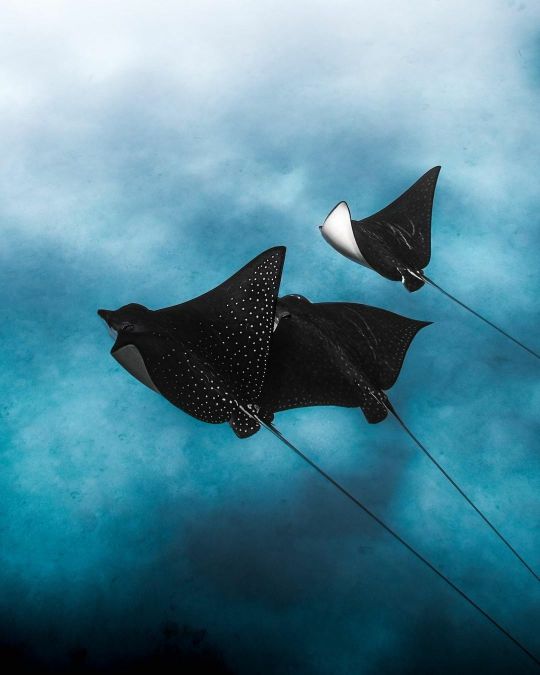
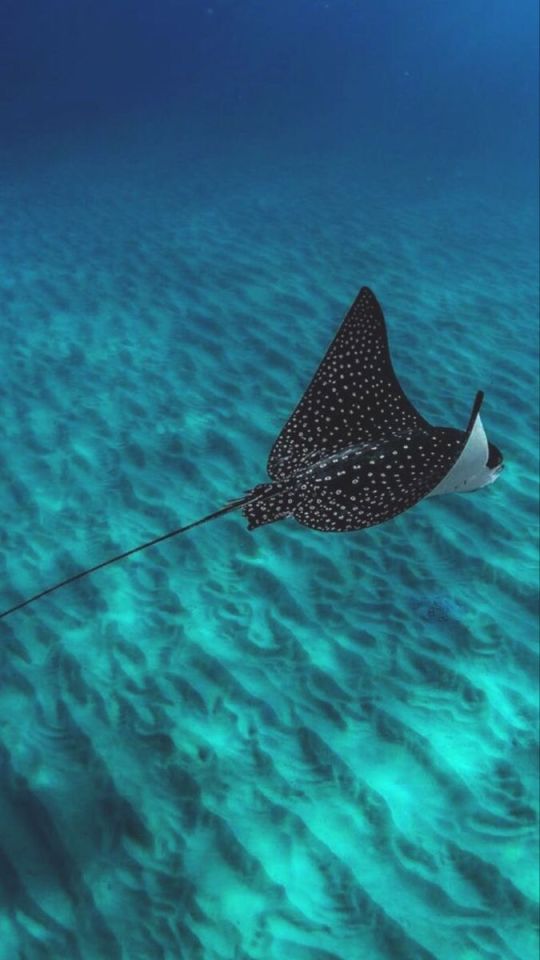
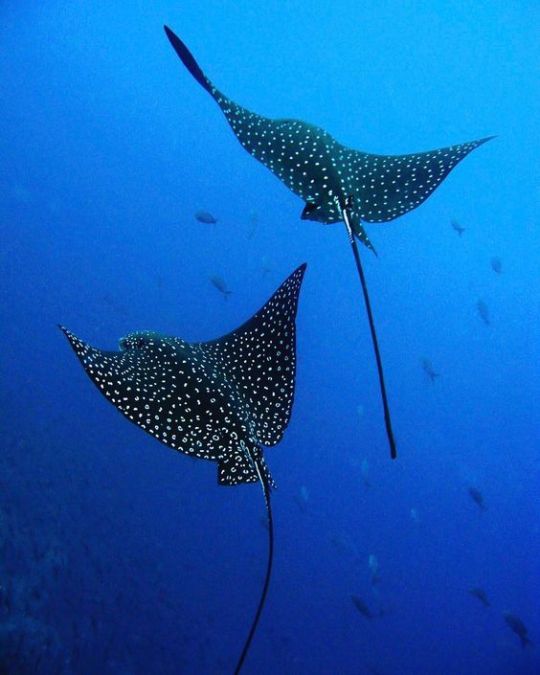
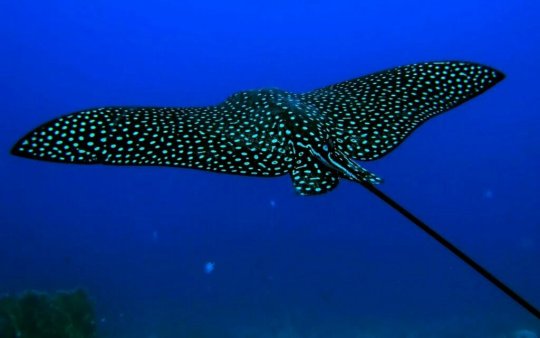
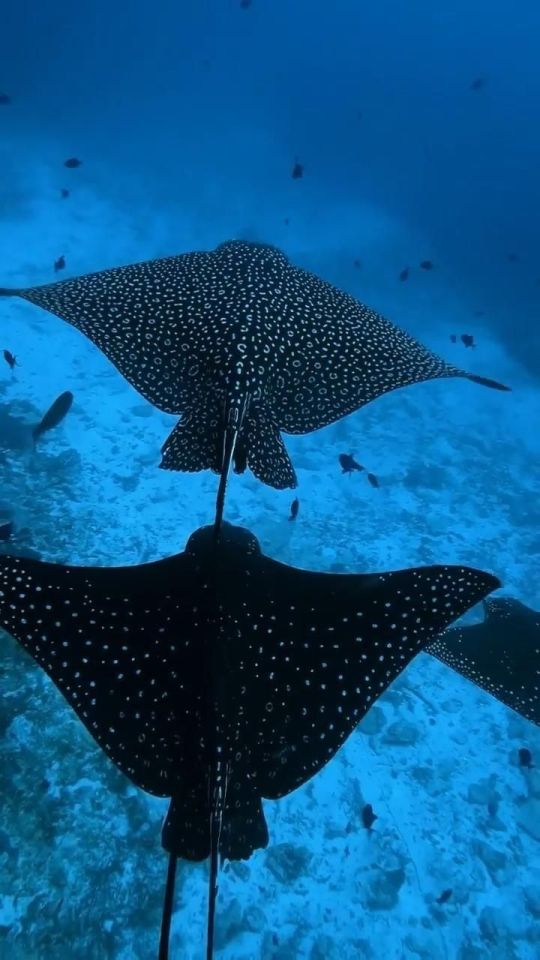

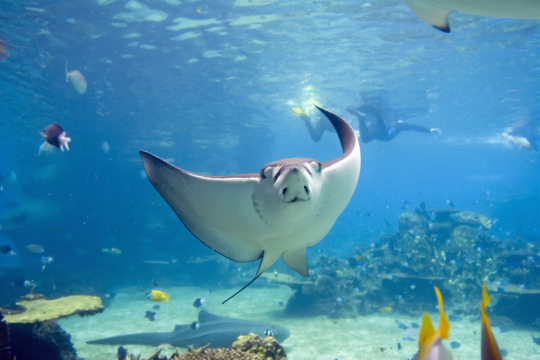
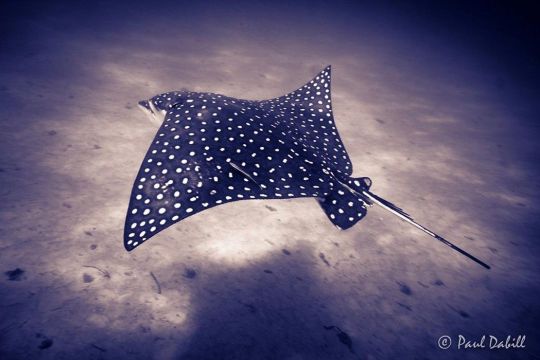
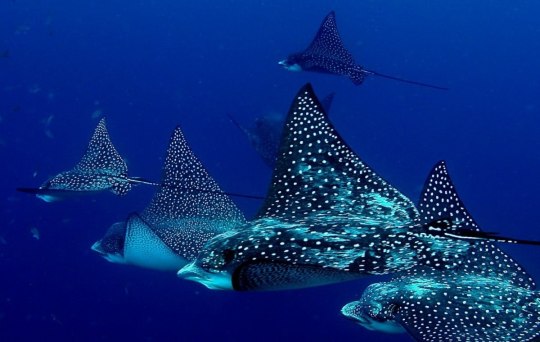

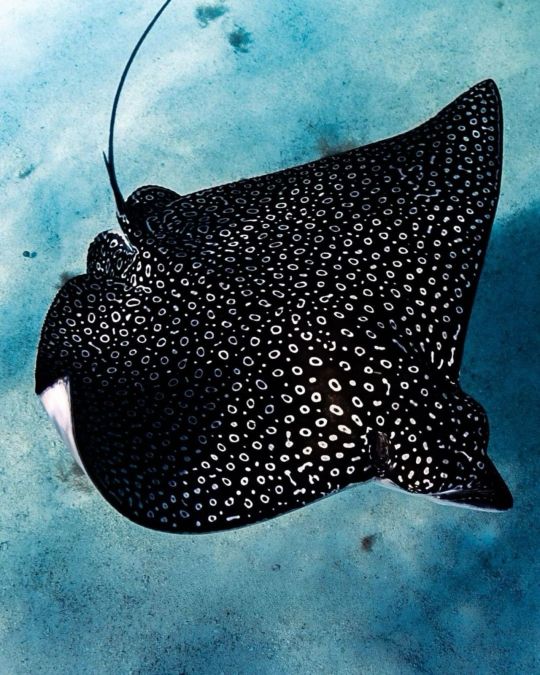
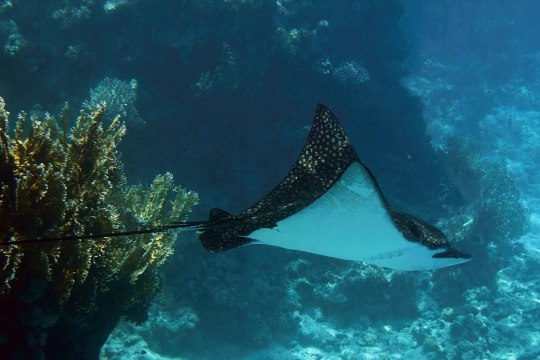
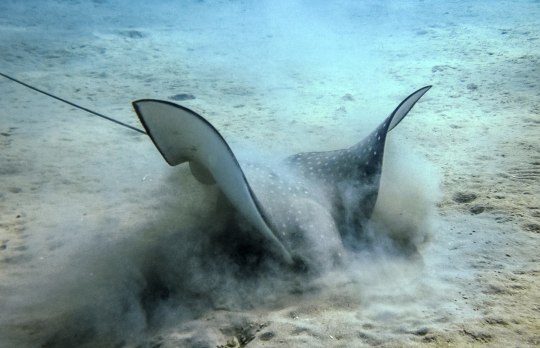
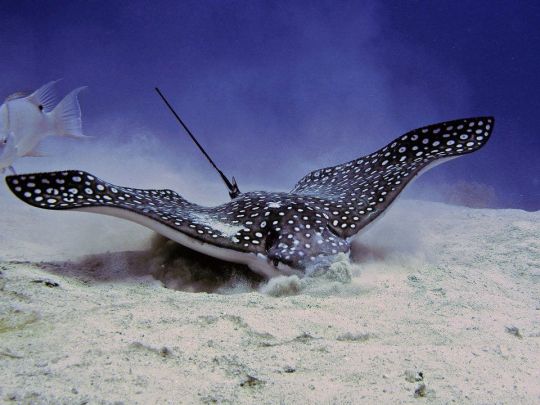
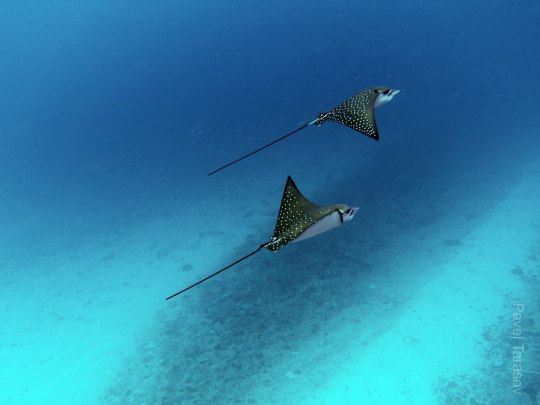
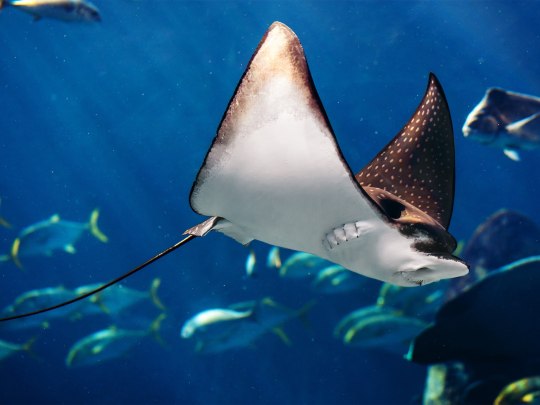
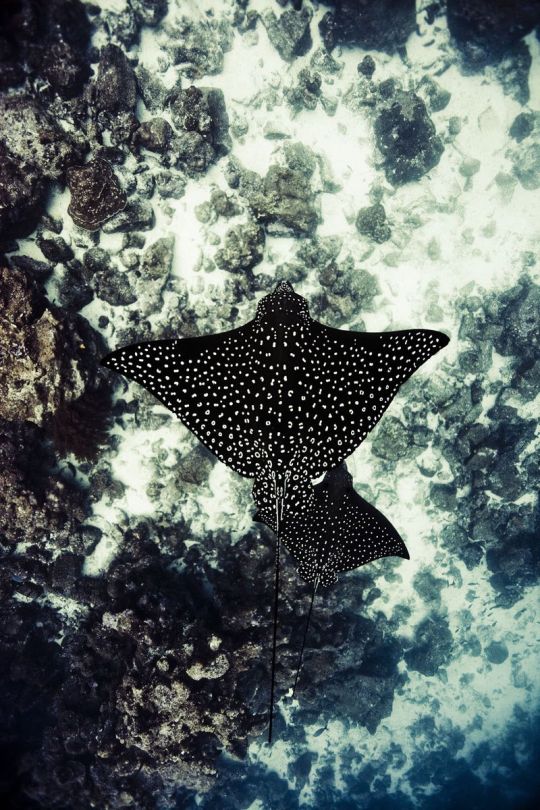
Обыкновенный пятнистый орляк (Аetobatus narinari).
Это — вид хрящевых рыб одно��мённого рода семейства орляковых скатов. Пятнистый орляк принадлежит к роду Aetobatus, его видовое название можно перевести, как «орел–скат». Это скат крупных размеров (до 8,8 м с хвостом), у которого максимальный размах плавников-крыльев может доходить до 330 см, толщина тела в районе головы – 50 см, а вес до 230 кг. Скат орляк похож на парящую под водой хищную птицу -- не зря он получил свое название. Движения его плавников похожи на взмахи крыльев, нос на птичий клюв. Спинная поверхность орляка окрашена в темно-синий или чёрный цвет с белыми точками, брюшная сторона — белая. Хвост длиннее, чем у других скатов, и несёт на себе 2—6 ядовитых шипов.
Широко распространён в тропической зоне, включая Мексиканский залив, Гавайские острова, вдоль побережья западной Африки, в Индийском океане, Океании и вдоль обоих побережий Америки на глубине до 80 м. Обычно ведет одиночный образ жизни, но вне сезона размножения может образовывать крупные стаи. В дикой природе , если пятнистого орляка не трогать , то это животное неопасно и пугливо. Но , если , нечайно наступить на пятнистый орляк , то он обвивает ногу хвостом, наступившего на рыбу пловца , или рыбака и вонзает ядовитые шипы.Часто люди получают рваные раны, которые необходимо промыть и лечить.
Пятнистый орляк имеет охранный статус на Большом Барьерном рифе вдоль восточного побережья Австралии.
Eagle spotted stingray(Aetobatus narinari).
It is a species of cartilaginous fish of the eponymous genus of the eagle ray family. The eagle spotted stingray belongs to the genus Aetobatus, its specific name can be translated as "eagle–stingray". This is a large-sized stingray (up to 8.8 m with a tail), whose maximum wingspan can reach 330 cm, body thickness in the head area is 50 cm, and weight is up to 230 kg. The eagle stingray looks like a floating chi under watera bird of prey -- it got its name for a reason. The movements of its fins are similar to the flapping of wings, its nose is like a bird's beak. The dorsal surface of the eaglet is colored dark blue or black with white dots, the ventral side is white. The tail is longer than that of other stingrays and carries 2-6 poisonous spikes.
It is widespread in the tropical zone, including the Gulf of Mexico, the Hawaiian Islands, along the coast of West Africa, in the Indian Ocean, Oceania and along both coasts of America at depths up to 80 m. It usually leads a solitary lifestyle, but outside the breeding season it can form large flocks. In the wild, if the eagle spotted stingray is not touched, then this animal is harmless and timid. But if you step on a eagle stingray, it wraps its tail around the leg of a swimmer or fisherman who stepped on a fish and pierces poisonous thorns.People often get lacerations that need to be washed and treated.
The eagle spotted stingray has a protected status on the Great Barrier Reef along the east coast of Australia.
Источник://seaforum.aqualogo.ru/topic/59066-обыкновенный-пятнист%C2%AD%C2%ADый-орляк-аetobatus-narinari/, /ru.wikipedia.org/wiki/Обыкновенныйпятнистыйорляк, pofoto.club/29020-obyknovennyj-pjatnistyj-orljak.html, ru.pinterest.com/pin/985231163169913/,t.me/+HLoqW4OcT5VjZjM6.
#fauna#video#animal video#marine life#marine biology#nature#aquatic animals#sea creatures#ocean#sea#fish#eagle spotted stingray#reef#sand#seaweed#beautiful#animal photography#nature aesthetic#видео#фауна#природнаякр��сота#природа#океан#море#скат#пятнистый орляк#рыбы#песок#риф#водоросли
733 notes
·
View notes
Note
la squadra, but merman AU 🧜🏻♂️








I thought this question was a great idea until I remembered how much I suck at design
And I would probably just skip this request because hah, maybe I should suck to everyone here too???
But then I remembered that I have a note with fish species for La Squadra for a long time, but I didn't really want to implement it, so this question became a kind of impetus
So
About the types of sea creatures:
● Risotto - Zebra moray ● Pesci - Porcupinefish (Beach boy - piranha) ● Prosciutto - European lobster ● Gelato - Seehorse (see dragon) ● Sorbet - Stenopodidea ● Formaggio - Mantis shrimp ● Illuso - Sea bunny ● Ghiaccio - Aetobatus narinari ● Melone - Blue-ringed octopus (Baby face - Lamprey, BF's junior - hangfish)
Guess who i started to hate in the process
#jjba#vento aureo#jojo fanart#la squadra#la squadra esecuzioni#golden wind#risotto nero#pesci#prosciutto#sorlato#illuso#formaggio#ghiaccio#melone
208 notes
·
View notes
Note
Trick or treat! 🎃
You get a spotted eagle ray (Aetobatus narinari)!

55 notes
·
View notes
Note
So ive got a huge love for rays, could I perhaps ger a random ray?

You get a Spotted Eagle Ray
Aetobatus narinari
61 notes
·
View notes
Text

Spotted Eagle Ray (Aetobatus narinari), feeding, family Aetobatidae, Roatan, Honduras
ENDANGERED.
photograph by Bosco Bearbones
#eagle ray#ray#elasmobranch#aetobatus#aetobatidae#fish#ichthyology#animals#nature#ocean#caribbean#central america
217 notes
·
View notes
Text

▪️Aetobatus narinari, popularly known as the spotted stingray, is a fish from the milliobatidae family. Its mouth resembles a bird's beak and its tail resembles a whip with 1 to 5 needles. The dorsal bark is dark blue with white spots; The ventral region is white, providing effective camouflage when viewed from above or below.
457 notes
·
View notes
Text
While getting photos for the other night, I also got some photos of this guy for tonight. This stingray is located in the oceans, and is purely there for ambiance. It cannot be scanned with the Focus, it cannot be caught, and it cannot be killed.
Judging by the spots on the back, the location I found it in, and the diamond-like shape, I can assume that this is based off of the Aetobatus Narinari (Spotted Eagle Ray)


These rays have venomous barbs that work as a stinger, which is attached to their tails. These tails are where the stingray actually gets its name, as it’s used to sting its prey.


And here I have some photos where I used the vintage filter at 0.50 to tone down the blue hues to get a closer idea of the actual color scheme these rays have. I used the same filter in the photos I used to showcase the tail/stinger so it would have a higher contrast with the background.


21 notes
·
View notes
Text
Raphael can be a Coelacanth bc they deserve it. Michael can be a Aetobatus ocellatus idk
All the archangels should be prehistoric things actually that makes sense. Gabriel is a Hymenocaris vermicauda
6 notes
·
View notes
Text

FR Heyy! Mon moral n'était pas au top ces derniers temps donc j'ai juste voulu faire quelque chose dans ma zone de confort (genre vibe de déesse de la mer) — en collaboration avec des méduses aurélie (Aurelia aurita), une Chrysaora fuscescens et une raie léopard (Aetobatus narinari) Je me suis aussi amusée avec des washi tapes (selon moi, du matos artistique vraiment sous-côté) Dans l'ensemble, je suis assez contente de ces dessins et j'ai déjà hâte d'en faire de nouveaux (ah et aussi j'adore la pose en bas à gauche teehehehehehehehe) _ _ _ _ _ _ _ _ _ _ _ _ _ _ _ _ _ _ _ _ _
🇬🇧 Heyy! I haven't been feeling really great lately so I guess I just wanted to make something very much in my comfort zone (kinda sea goddess vibe) — featuring moon jellyfish (Aurelia aurita), a Pacific sea nettle (Chrysaora fuscescens) and a spotted eagle ray (Aetobatus narinari) I also wanted to have some fun with washi tapes (very underrated art supply imo) Overall I'm happy with this piece and I can't wait to start a new one (ah and I absolutely adore the pose in the bottom left corner teehehehehehehehe)
Close ups:
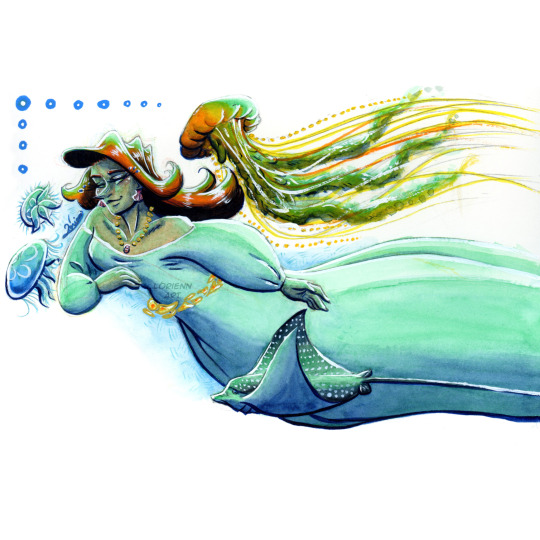


#artists on tumblr#watercolor#watercolour#washi tape#sea goddess#sea animals#jjba#jojo's bizarre adventure#jojos bizarre adventure#jojo no kimyou na bouken#jotawife#jotaro kujo#jolyne's mom#jolynes mom#mrs kujo#I was born to make Jotaro Kujo crawl at the feet of his woman
38 notes
·
View notes
Text

Birthday Whales - by Namu the Orca
Species depicted: Killer whale (Orcinus orca), Beluga whale (Delphinapterus leucas) and Spotted eagle ray (Aetobatus narinari) Time taken: Many, many hours References use: A lot for markings of the characters and belugas, though only anatomy refs were for the rays:
3 notes
·
View notes
Text




Image 1 : Cownose Ray - Rhinoptera bonasus
Fun Fact : While feeding at the bottom of the ocean, cownose rays create micro-habitats for tiny invertebrates!(≧���≦)
Image 2 : Round Ray - Urobatis halleri
Fun Fact : To camouflage, Round Rays bury themselves in mud / sand with only their eyes poking & spiracles (breathing holes under the eyes) poking out. How adorable !(^。^)
Image 3 : Spotted Eagle Ray - Aetobatus narinari
Fun Fact : Spotted Eagle Rays can jump about six feet above the ocean's surface ! They also each have their own spot pattern, like a fingerprint!(*'▽'*)
September 7 , 2023(^^)
#ocean#stingrays#stingray#salt water#marine biology#fun facts#cownose ray#eagle ray#round ray#scientific names#meow
28 notes
·
View notes
Text
Facts of the Day: 🌊Spotted Eagle Rays🌊

Scientific Name: Aetobatus narinari
Length: 8.2 feet without the tail, 16.4 feet with the tail on average
Weight: 507 lbs maximum
Lifespan: Around 25 years
Reproduction: They give birth to live young with their litters being between 1 to 4 pups
Diet: Clams, oysters, shrimp, octopus, squid and sea urchins as well as bony fishes
Habitat: Warm coastal waters worldwide
Status: Near threatened
Summary: Spotted Eagle Rays are a very interesting species of ray, with a distinct snout used to dig through sand for their prey. They also are covered in white spots and rings that leave them with a striking appearance. While these rays are pretty, they also have a deadly weapon at their disposal. Spotted Eagle Rays are equipped with a venomous barbed stinger that can cause serious wounds and injury to humans that get on their bad side. Despite this, attacks by these rays are very scarce as they are shy and tend to avoid humans. Most attacks from this species were due to being heavily provoked or mishandled when captured. These rays also have a habit of breaching the water, capable of flying up to six feet into the air. It’s unknown the exact reason that these rays show breaching behaviors but it’s hypothesized to be to shake off parasites, avoid predators or unwanted mates, or even possibly just for fun.

#baby shark bites!#spotted eagle rays#eagle rays#eagle ray#spotted eagle ray#Age Regression#Agere#age regressor#sfw regression#sfw regressor#sfw age regression#sfw age regressor#sfw agere#petre#pet regressor#pet regression#sfw petre#sfw pet regressor#sfw pet regression
29 notes
·
View notes